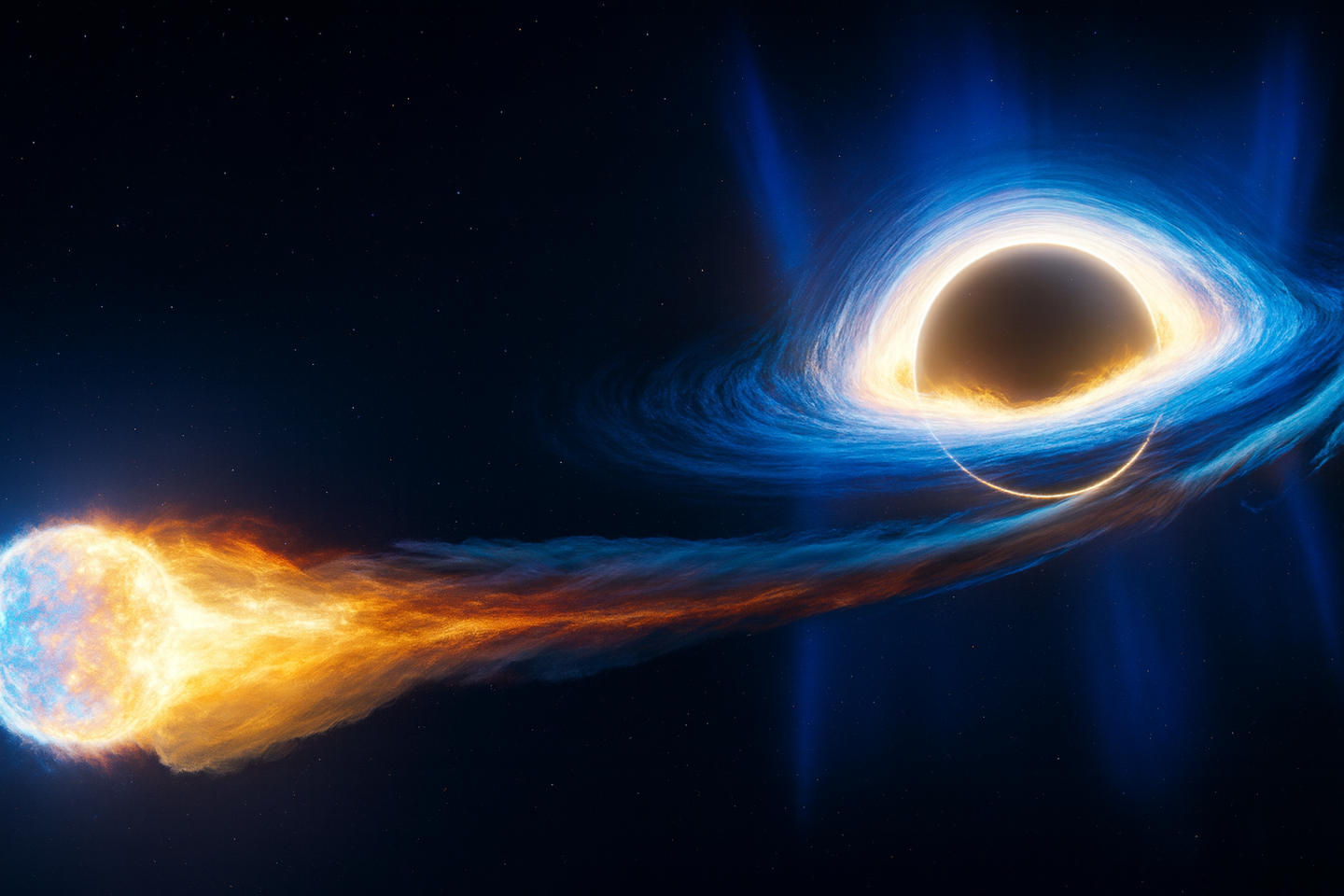Astronomers spot a black hole ripping apart a star outside a galaxy’s center
Astronomers find the first off-center black hole shredding a star, creating the fastest-evolving radio signal ever observed.

Astronomers discovered a black hole tearing apart a star far from a galaxy’s center. (AI-generated / The Brighter Side of News)
Astronomers have witnessed something that no one believed possible: a black hole ripping apart a star not at the center of a galaxy, but far from it. More amazingly, the event's radio waves pulsed and faded more quickly than any ever before, upending what scientists believed about how black holes behave when they consume stars.
The phenomenon, a tidal disruption event (TDE), happens when a star strays too close to a supermassive black hole. The black hole's gravity shreds the star apart, releasing bursts of energy that can outshine galaxies. They tend to happen most often at the center of a galaxy, where the largest black holes live. But this one, designated AT 2024tvd, bucks the trend.
A Black Hole Out of Place
AT 2024tvd was first discovered by the Zwicky Transient Facility, which surveys the evening sky for sudden changes in brightness. First images seemed to show the flare near the center of a galaxy's nucleus. But closer examination revealed something unexpected: the source was around 2,600 light-years—some 0.8 kiloparsecs—outside the nucleus of the galaxy. That makes it "off-nuclear" since the black hole isn't stationary at the galaxy's center like most supermassive black holes.
It's absolutely amazing," Dr. Itai Sfaradi of the University of California, Berkeley, the study's author, said. "We never before witnessed so strong radio emission from a black hole tearing apart a star outside a galaxy's core, and changing this in such a short time. It redrew our concept of black holes and their behavior.".
Sfaradi’s mentor, Prof. Assaf Horesh from the Hebrew University of Jerusalem, shared in the excitement. “This is one of the most fascinating discoveries I’ve been part of,” he said. “The fact that it was led by my former student makes it even more meaningful.”
Chasing the Signal
To witness the phenomenon, researchers used some of the world's most sensitive radio telescopes: the Very Large Array in New Mexico, the Atacama Large Millimeter/submillimeter Array in Chile, the Allen Telescope Array, the Arcminute Microkelvin Imager Large Array in the UK, and the Submillimeter Array in Hawaii. Together, these telescopes painted an amazing picture of a black hole behaving unlike any seen before.
Photometric observations from these telescopes showed two distinct radio spikes of brightness—one 131 days after discovery and the other around 194 days later. The first rise was a sharp power law (F ∝ t⁹), then dropped precipitously (F ∝ t⁻⁶). The second flare increased even more rapidly, with the brightness increasing as F ∝ t¹⁸ before falling rapidly (F ∝ t⁻¹²). These are the most recent most extreme slopes, and that makes AT 2024tvd the most rapidly evolving radio TDE ever recorded.
The AMI-LA data, led by the Hebrew University team, played a critical role in capturing the event’s speed and intensity. “It’s rare to see such rapid changes in the radio band,” said Horesh. “This tells us that the outflows from the black hole were not only powerful but evolved in a way we’ve never observed.”
Two Explosive Outbursts or One Complicated One?
The two-peaked radio shape baffled scientists. Was it a single ejection of material that ran into twice-interacting ambient gas, or two separate outbursts hurled off at different times? Computer simulations state that either is possible, but the scientists themselves favor two distinct ejection events—a first some 84 days after the optical discovery and a second a few months afterward.
If so, the black hole "awakened" after a quiet spell of time, spewing new streams of matter many years subsequent to the initial shredding of the star. Such activity implies that black holes may have had postponed feeding binges with staged displays of energy instead of a single giant explosion.
The scientists also considered the effects of absorption, in which gas clouds stop or weaken radio waves, and the cooling processes like synchrotron and inverse Compton radiation, which control the manner in which the signals evolve with time. Despite considering these effects, the scientists found it challenging to explain the radio patterns using a single outflow.
A Record-Breaking Event
AT 2024tvd is unique for a number of reasons. The first is its position—located far from the galactic center, where few supermassive black holes would be predicted. This implies that some black holes must drift through galaxies after being expelled from their orbits near the center, perhaps during galactic mergers.
Second is the incredible radio speed of evolution. How quickly it rose and then fell exceeds any previous tidal disruption event, which means there's a new level of complexity to how matter can be ejected from the grasp of a black hole.
Finally, the second flare being more luminous than the first one is very rare. For many TDEs, the light vanishes after the initial flash. In this case, the second act was even more sensational, suggesting multiple or repeated ejection of material.
Radio Waves and X-Rays in Concert
To the mystery, an initial radio burst was followed by a new X-ray emission from the same area. That X-ray radiation was a power-law spectrum typical of inverse Compton scattering—where high-energy electrons interact with low-frequency photons.
The coincidence indicates that there is a connection between the X-ray-producing area near the black hole and the radio-emitting outflows at greater distances. It might help scientists trace the process from star destruction to the injection of high-energy jets.
The discovery of AT 2024tvd disrupts established theories on where black holes live and what occurs when they devour stars. It shows that supermassive black holes do not necessarily remain at the heart of galaxies but can travel through them. Such drifters could be triggered by galactic collisions or gravitational slingshots that push them into new groups.
The phenomenon also indicates black hole outflows are feasible in multiple stages with individual bursts of energy and radio light. This complicates the existing models, which forecast a single burst after a star dies. Instead, AT 2024tvd suggests black holes may have an even more unstable and episodic feeding pattern.
Practical Implications of the Research
AT 2024tvd offers a new perspective on black holes' behavior and their surroundings, where astronomers can now investigate regions of galaxies which were previously considered lifeless. By showing that in certain situations black holes can live and feed far from the middle of galaxies, this will guide future surveys to look for them in locations other than usual.
It also heightens understanding of how matter behaves under strong gravity—knowledge that powers cosmological models to high-energy physics research.
For human beings, it underpins how much more remains to be learned about the universe and how far science can push with curiosity.
Research findings are available online in The Astrophysical Journal Letters.
Related Stories
- Astronomers capture first-ever image of two black holes orbiting each other
- How black holes generate massive magnetic and particle-driven jets
- Black hole stars: Giant stars may hide black holes at their core
Like these kind of feel good stories? Get The Brighter Side of News' newsletter.
Joseph Shavit
Science News Writer, Editor-At-Large and Publisher
Joseph Shavit, based in Los Angeles, is a seasoned science journalist, editor and co-founder of The Brighter Side of News, where he transforms complex discoveries into clear, engaging stories for general readers. With experience at major media groups like Times Mirror and Tribune, he writes with both authority and curiosity. His work spans astronomy, physics, quantum mechanics, climate change, artificial intelligence, health, and medicine. Known for linking breakthroughs to real-world markets, he highlights how research transitions into products and industries that shape daily life.



